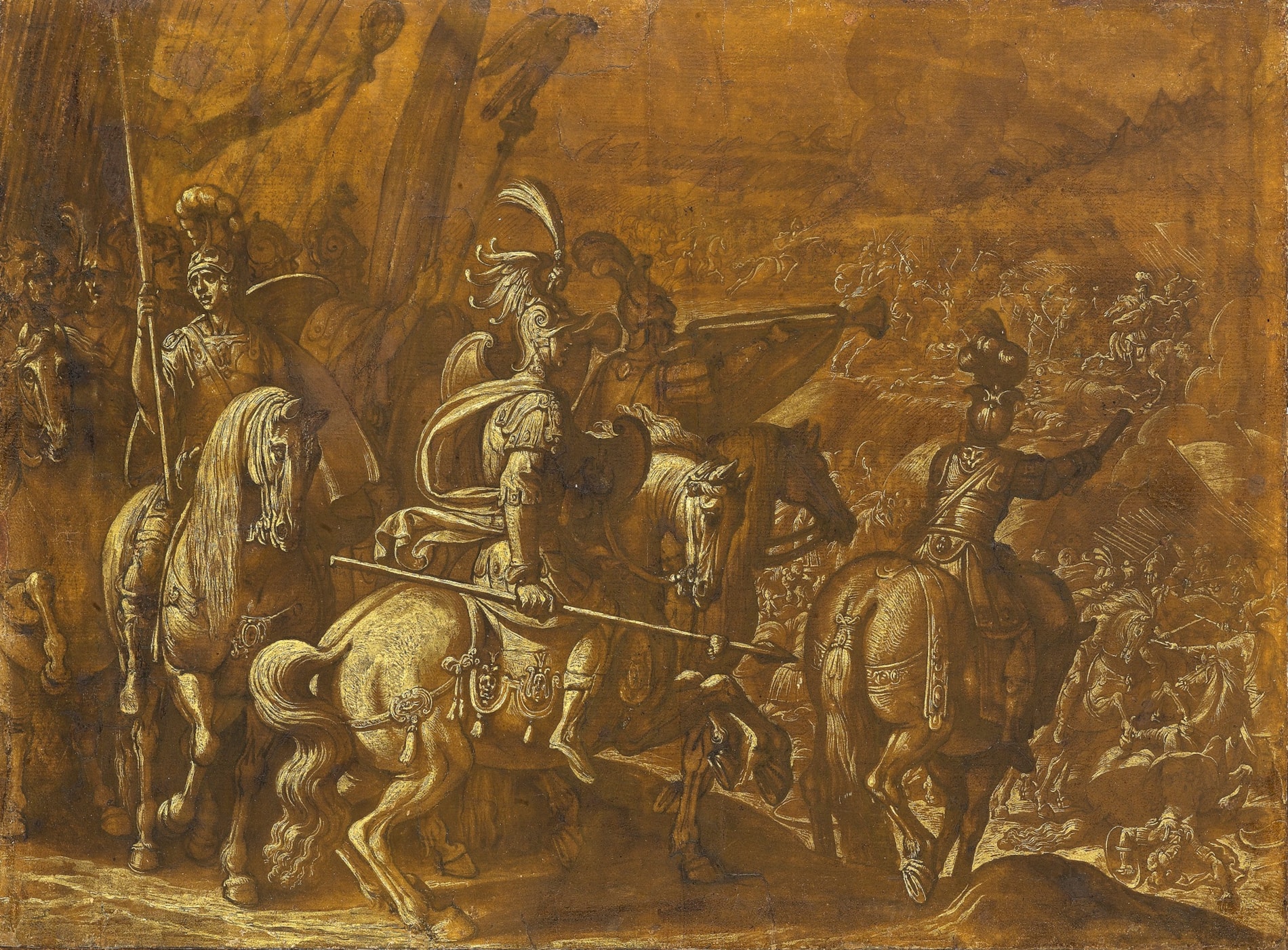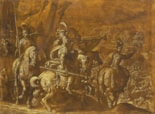Antonio TEMPESTA
(Florence 1555 - Rome 1630)
A Battle Scene
Sold
Pen and brown ink and brown wash, extensively heightened with gold, over traces of an underdrawing in black chalk, on paper washed brown.
The sheet backed and laid at the edges onto a fictive mount.
Some areas of the sheet made up and repaired.
353 x 518 mm. (13 7/8 x 20 3/8 in.) [sheet]
393 x 557 mm. (15 1/2 x 22 in.) [including fictive mount]
The sheet backed and laid at the edges onto a fictive mount.
Some areas of the sheet made up and repaired.
353 x 518 mm. (13 7/8 x 20 3/8 in.) [sheet]
393 x 557 mm. (15 1/2 x 22 in.) [including fictive mount]
This drawing is unusual among Antonio Tempesta's drawings in its impressive scale and degree of finish. While its composition is similar to such etchings by Tempesta as Alexander the Great Directing a Battle or The Roman Commander Cerialis Attacks near Trier, as well as some of the scenes illustrating Tasso’s Gerusalemme Liberata, this very large sheet - drawn with extensive heightening in gold and with the addition of a fictive mount border - must have been intended as a finished, independent work of art.
In this context, it is interesting to note what may possibly be a reference to this drawing, or one like it, in the manuscript inventory of paintings belonging to the noted 17th century Roman collector Cardinal Scipione Borghese (1577-1633). The inventory, which may be dated to between 1615 and 1630, lists two large framed drawings by Tempesta: ‘Doi disegni chiari oscuri in carta gialla con cornice negra alti 1 2/3 larghi 5 1/4. Tempesta’5 (‘Two drawings in chiaroscuro on dark yellow paper with black frames, height 1 2/3, width 5 1/4, by Tempesta’).
As Eckhard Leuschner has noted, with reference to the present sheet, ‘Among the surviving documentary evidence of Scipione Borghese's Tempesta acquisitions, the Doi disegni oscuri chiari con cornice in carta gialla negra are especially interesting. They must have been pictorial drawings by the artist executed on paper, representing, in their monochromatic composition, the antique bas-reliefs he valued. One – albeit damaged – example of Tempesta’s elaborate technique was on the art market some years ago: on brown paper (probably the above-mentioned carta gialla), one can see a line of mounted soldiers in ‘antique’ armour in the foreground, moving from a small hill towards a battle in the middle and far distance. In its composition the drawing is reminiscent of the etchings of the Alexander series, but this is not a rapid sketch but a highly elaborate drawing by Tempesta. The drawing is not only executed with brown washes and white heightening, but also has various accents in gold, which gives it the impression of something precious, which must have appealed to a collector like Scipione Borghese, who was obsessed with art treasures and kunstkammer objects.’
While this impressive Battle Scene may not be definitively identifiable as one of the two large framed drawings by Antonio Tempesta in the Borghese collection, the mention of such sizeable and highly finished drawings in one of the most prominent Roman collections would suggest that the artist must have occasionally produced such elaborate works as this for sale to prominent collectors and connoisseurs.
In this context, it is interesting to note what may possibly be a reference to this drawing, or one like it, in the manuscript inventory of paintings belonging to the noted 17th century Roman collector Cardinal Scipione Borghese (1577-1633). The inventory, which may be dated to between 1615 and 1630, lists two large framed drawings by Tempesta: ‘Doi disegni chiari oscuri in carta gialla con cornice negra alti 1 2/3 larghi 5 1/4. Tempesta’5 (‘Two drawings in chiaroscuro on dark yellow paper with black frames, height 1 2/3, width 5 1/4, by Tempesta’).
As Eckhard Leuschner has noted, with reference to the present sheet, ‘Among the surviving documentary evidence of Scipione Borghese's Tempesta acquisitions, the Doi disegni oscuri chiari con cornice in carta gialla negra are especially interesting. They must have been pictorial drawings by the artist executed on paper, representing, in their monochromatic composition, the antique bas-reliefs he valued. One – albeit damaged – example of Tempesta’s elaborate technique was on the art market some years ago: on brown paper (probably the above-mentioned carta gialla), one can see a line of mounted soldiers in ‘antique’ armour in the foreground, moving from a small hill towards a battle in the middle and far distance. In its composition the drawing is reminiscent of the etchings of the Alexander series, but this is not a rapid sketch but a highly elaborate drawing by Tempesta. The drawing is not only executed with brown washes and white heightening, but also has various accents in gold, which gives it the impression of something precious, which must have appealed to a collector like Scipione Borghese, who was obsessed with art treasures and kunstkammer objects.’
While this impressive Battle Scene may not be definitively identifiable as one of the two large framed drawings by Antonio Tempesta in the Borghese collection, the mention of such sizeable and highly finished drawings in one of the most prominent Roman collections would suggest that the artist must have occasionally produced such elaborate works as this for sale to prominent collectors and connoisseurs.
Active as a painter and frescante, as well as a draughtsman and printmaker, Antonio Tempesta was probably trained in the studio of Jan Stradanus in Florence. Like Stradanus, he may have worked under the supervision of Giorgio Vasari on the decoration of the Palazzo Vecchio. He was also a pupil of Santi di Tito, and is listed as a member of the Accademia del Disegno in Florence in December 1576. Not long afterwards, however, he settled in Rome, where he worked for the remainder of his career. Tempesta was employed by Pope Gregory XIII on the fresco decoration of several rooms in the Vatican, and also received commissions for paintings and fresco decorations for various churches and palaces in Rome. Further afield, he participated in the decoration of rooms at the Villa d’Este in Tivoli, the Palazzo Farnese at Caprarola and the Villa Lante at Bagnaia; the latter decorated with frescoes of hunting scenes. He also painted a number of easel pictures, sometimes on coloured stone. Although he worked in Rome for most of his career, Tempesta continued to earn significant commissions from Florentine patrons, including the Medici Grand Dukes, for whom he painted several battle scenes, as well as a Resurrection of Christ for the church of Santa Felicità in Florence. The artist remained active until at least 1627.
Antonio Tempesta’s work as a painter remains much less well known today, however, than his activity as a draughtsman and printmaker. He was a productive etcher who, as one scholar has noted, ‘stands out as one of the most prolific and influential printmakers of the 17th century...[and] dominated the printmaking business in Rome between 1590 and 1630.’ Tempesta created more than 1,400 prints, including a large number of hunting and battle scenes. He also produced several etchings of battles between Christian soldiers and cavalry and infidel troops to illustrate editions of Torquato Tasso’s epic poem Gerusalemme Liberata. These kinds of cavalry and battle scenes are also the subject of many of the artist’s drawings, which often find echoes in his etchings. Tempesta’s battle compositions are generally scenes of dramatic action but often lack a single dominant figure, nor is there usually any sustained attempt at a narrative context. The artist’s interest in depictions of military campaigns and hunting scenes may be a legacy of his training with Stradanus in Florence, where he also would have seem similar battle scenes throughout the decoration of the Palazzo Vecchio.
Antonio Tempesta was a fairly prolific draughtsman (though the number of his extant drawings is not on a par with that of his countless prints), and a large number of drawings by him are today in the collection of the Louvre, while other groups are in the British Museum, the Royal Collection at Windsor Castle, and elsewhere.
Provenance
Possibly Cardinal Scipione Borghese, Rome
Part of a collection of drawings formed in Tuscany in the 18th century
Comte Eugène d’Oultremont, Chateau de Presles, Aiseau-Presle, Belgium, and thence by descent until 1986
Anonymous sale (‘The Property of a Nobleman’), London, Christie’s, 1 July 1986, lot 56
Hazlitt, Gooden & Fox, London
Anonymous sale, New York, Sotheby’s, 8 January 1991, lot 108
Private collection, France, until 2011.
Part of a collection of drawings formed in Tuscany in the 18th century
Comte Eugène d’Oultremont, Chateau de Presles, Aiseau-Presle, Belgium, and thence by descent until 1986
Anonymous sale (‘The Property of a Nobleman’), London, Christie’s, 1 July 1986, lot 56
Hazlitt, Gooden & Fox, London
Anonymous sale, New York, Sotheby’s, 8 January 1991, lot 108
Private collection, France, until 2011.
Literature
Eckhard Leuschner, Antonio Tempesta: Ein Bahnbrecher des römischen Barock und seine europäische Wirkung, Petersberg, 2005, pp.489-490, fig.14.19; Francesco Gatta, ‘Alcuni inediti o poco noti dipinti a chiaroscuro di Antonio Tempesta dalle collezioni nobiliari romane del Seicento’, Studi di Storia dell’Arte, 2020, p.115, note 19.
Exhibition
London, Hazlitt, Gooden & Fox, European Drawings, 1988, no.20.






